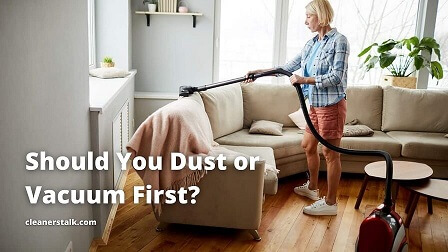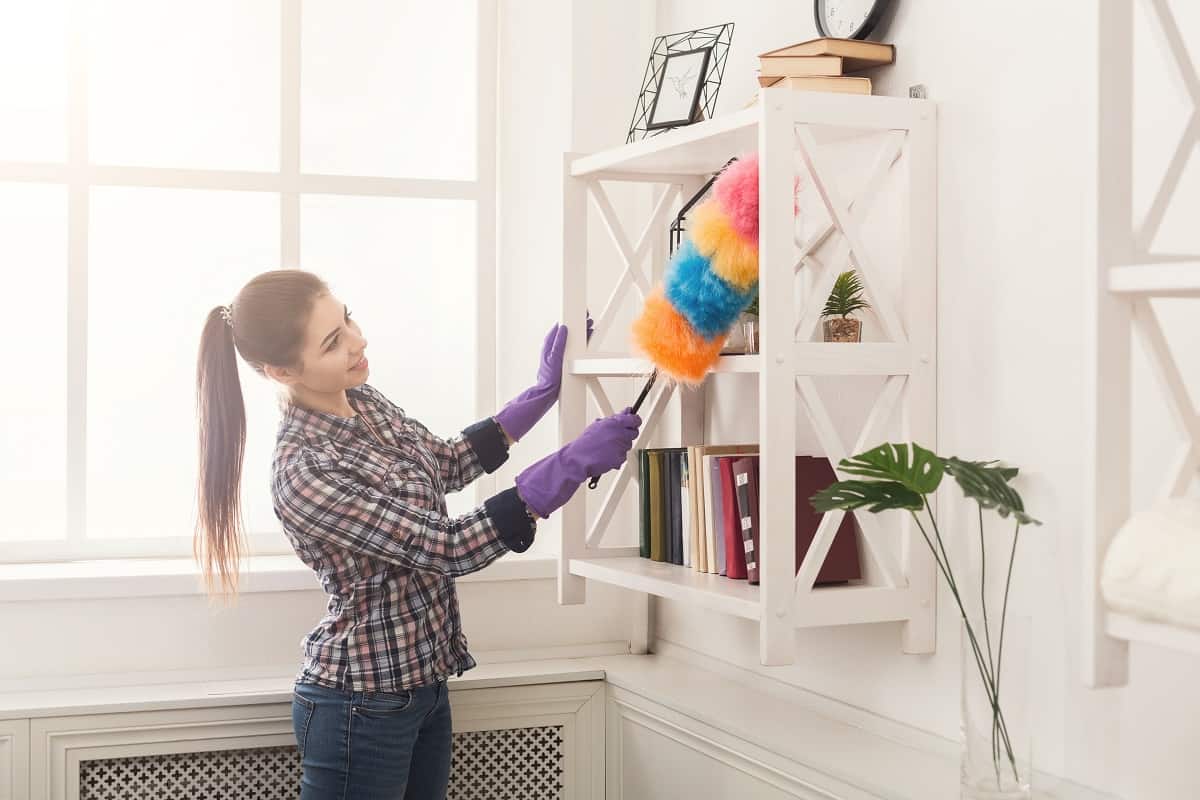
Should You Dust or Vacuum First? Read This First
Cleaners Talk is reader-supported. This post contains affiliate links, we may earn a commission at no additional costs to you. As an Amazon Associate we earn from qualifying purchases.
When it comes to cleaning your house, you’ve probably wondered whether to dust or vacuum first. And while there’s no right or wrong way of cleaning your house, it would help to consider a few things. Each approach has its own set of advantages and disadvantages. Here’s everything you need to know:
Should you dust or vacuum first? Always dust first before you vacuum. By dusting first, you are agitating the dust particles, hopefully allowing them to settle in an easier location. Following up with a vacuum allows you to pick up the remaining dust particles, resulting in a more thorough cleaning.
However, the best cleaning process is not as simple as only dusting, and then vacuuming. There are several important things to consider to clean your house effectively. In this post, we will answer the question: should you dust or vacuum first? We will also share the best tips on dusting and vacuuming as well. Let’s get started.
Why Should You Dust?
Dust is a combination of fine particles of solid matter. This includes human skin cells, fabric fibers, pet dander, dust mite excrement, as well as dirt and debris. Not only does dust make surfaces look dirty, but they can also cause damage and scratching on household surfaces as well.
Additionally, dust can cause a myriad of health problems when left unattended. In fact, research published in the Epidemiology Journal suggests that exposure to dust can lead to mucosal symptoms and nasal congestion. This simply means that you may experience allergy and breathing problems.
It’s shocking how much dust can accumulate in a short period of time. Therefore, it is important to dust and vacuum on a regular basis. The combination of the two will help make your home look and feel better. Dusting and vacuuming regularly can also protect family members and the surfaces of your home.
Should You Dust or Vacuum First?
To thoroughly answer this question, we look for answers from Lita Coon, a professional house cleaner for 15 years, currently owner of a London-based cleaning company, Glimmr. As someone who is running her own cleaning company, this question is something she knows a lot of. The conclusion is:
Always dust first before you vacuum.
Let’s break it down. Dusting agitates everything that has settled on surfaces. This includes furniture, walls, fans, and ceilings. By dusting first, you are wiping some of those dust particles, but you are also agitating the remaining particles, hopefully allowing them to settle in an easier location.
Once the dust settles after the dusting process, you can then follow up with a vacuum. This allows you to pick up the remaining dust particles. Think of it as a second-line of defense against dust and debris. Anything you may have missed from the dusting process, a vacuum cleaner will pick it up.
However, the best process is not as simple as just dusting, and then vacuuming. Professional cleaners usually dust high up first, then vacuum, and then follow up by dusting the lower areas like tables. If you want to employ the techniques of professional cleaners, you can follow this simple dust-first process:
The Dust-First Process:

Dusting will agitate settled dust and may move them around to lower surfaces. It's important to dust before you vacuum.
1. Dust Higher Areas
Start by dusting higher areas. When it comes to cleaning, remember to start from the top, then work your way to the bottom. This includes fans, ceiling, and high shelves. Hopefully, any dust particles that are not trapped into the cloth or duster will fall into the lower areas or to the ground.
2. Vacuum Higher Areas
Next, vacuum all of the surfaces that are not on the floor. This includes walls, furniture, and drapes. If your vacuum cleaner comes with a hose extender, use it to your advantage. During this process, dust particles from higher surfaces may settle on lower surface areas and on the floor. Which brings us to...
3. Vacuum the Lower Areas and the Floor
Once you have vacuumed the higher areas, you need to vacuum the lower areas and the floor. Depending on the quality of your vacuum cleaner, this process may send dust and dirt flying in the room, which we will deal with in the next step. If your vacuum cleaner is outdated, consider buying a new vacuum cleaner.
4. Dust Your Lower Areas and the Floor
Last but not least, finish the entire cleaning process by dusting lower surface areas and the floor. It’s best to use a microfiber cloth, instead of a regular duster, to reduce any dust particles from flying back into the room. This entire cleaning process will maximize both the dusting and vacuuming process altogether.
Does Vacuuming Kick Up Dust?
Some vacuum cleaners may kick up dust and throw them back into a room. However, for a vacuum to do more harm than good, it has to be a really old vacuum cleaner that has never been cleaned. Generally, most vacuums take up more dust, dirt, and allergens than they release, especially cleaners with HEPA filters.
How long does it take for dust to settle after vacuuming?
According to the American College of Allergy, Asthma and Immunology, dust can take more than two hours to settle after thorough cleaning. This includes dusting, sweeping, and vacuuming. This is why it’s important to dust lower areas and the floor after vacuuming to clean your house effectively.
Final Verdict
And there you go, a simple post to answer the question: should you dust or vacuum first? If you vacuum first, then dust later, you are doing more work than you should have. Because when you dust, the particles that you don’t catch will end up on your recently vacuumed floors. This means you have to vacuum all over again.
When it comes to cleaning, remember to start from the top, then work your way to the bottom. This ensures that you pick up much more of the dust and debris that has had the time to settle on your house. By employing the dust-first process, you are doing your part to clean your house effectively and efficiently. 🙂
Related articles:
